Jan 9, 2024
Why you should visit Aizuwakamatsu in winter
Gallery - Why you should visit Aizuwakamatsu in winter
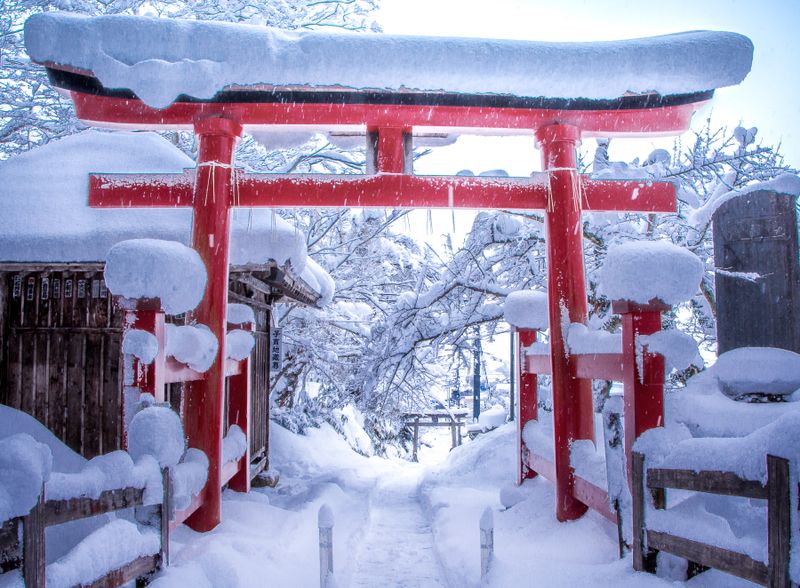
We’ve made a number of trips to the city of Aizuwakamatsu and the broader Aizu region in western Fukushima Prefecture, northern Japan, in recent years, and it’s during the winter that for us the city has been at its most captivating.
Why you should visit Aizuwakamatsu in winter
The temperatures might be unforgiving and the going tricky through heavy snow and on icy roads but it’s in the stark quiet of winter that the city’s tragic past is heard at its clearest, and its historical institutions appear at their most intoxicating. It’s also when the fiery pride of a people perhaps still politically ostracized due to conflicts past best warms the soul.
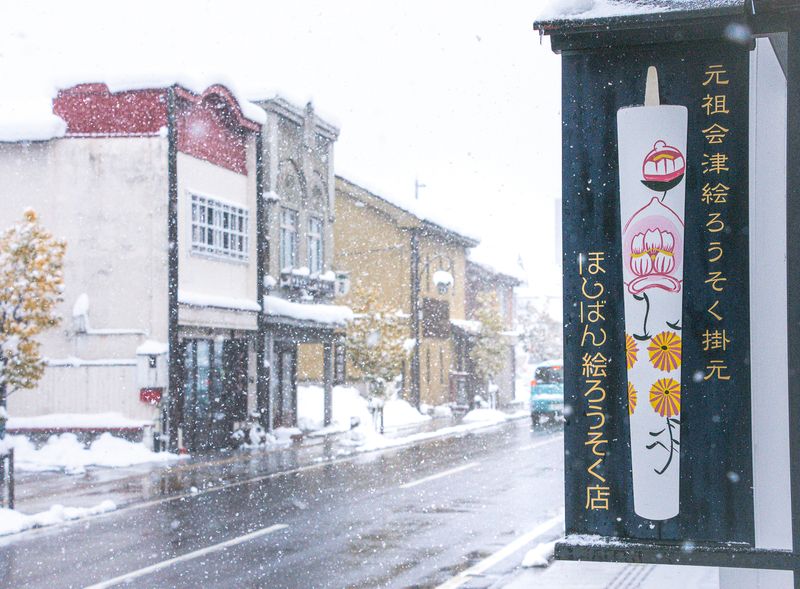
(Painted candle, or "e-rosoku," maker in Aizuwakamatsu's Nanokamachi district.)
Aizuwakamatsu, one of the last strongholds of samurai culture.
When Japan transitioned from the feudal Edo Period under the Tokugawa shogunate to the Meiji Period and the restoration of imperial rule in the late 19th century, Aizuwakamatsu, a city loyal to the shogunate, was where an army of Aizu clan samurai and other loyalists retreating north made one of their final attempts at halting their demise at the hands of imperial forces during the Boshin War (1868-1869).
The stand of the samurai and their supporters ended in failure and exile or an ever suffocating retreat further north for those who survived. The Aizu clan stronghold of Tsuruga Castle was raised to the ground. Stories of how local people met their end emerged from the rubble to haunt the city, and its visitors, to this day.
With the new Meiji government dominated by members of the Satcho Alliance (the military alliance between the feudal domains of Satsuma and Choshu (present day Kagoshima and Yamaguchi prefectures respectively) that opposed the shogunate) the people of Aizu were marginalized from positions of power after the war. Many feel this is still evidenced in the politics of Japan today.
Although the Aizu clan’s loyalty to the shogun ultimately led to its demise, the ruling samurai of the then Aizu Domain left behind a legacy of institutions, arts, commercial industry, and a local people in whose pride and endeavor can perhaps be heard echoes of the samurai spirit.
Hanitsu Shrine
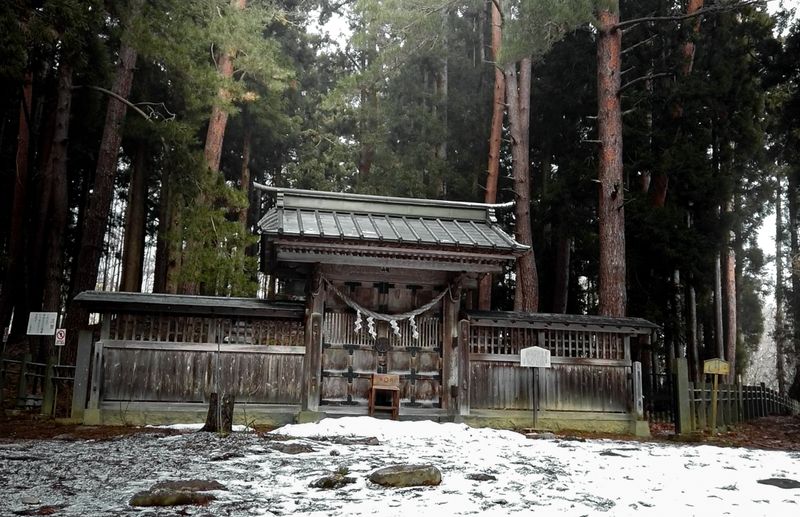
(Hanitsu Shrine during an a winter in the Aizu region which saw unusually light snows.)
Hanitsu Shrine is located at the foot of Mt. Bandai in the town of Inawashiro, northeast of Aizuwakamatsu. Enshrined here is Hoshina Masayuki (1611 - 1673), founder of the Matsudaira house of Aizu and the first Lord of Aizu.
Our second visit to the shrine in mid-February came during a winter which saw the region receive an unusually light amount of snowfall. It made the going easier for our visit, but the outlook uncertain for a region whose sake is made using water from thawed winter snows.
Hanitsu Shrine is where the visitor can start retracing Aizu’s turbulent past. In establishing the precepts of the Aizu Matsudaira family it was Hoshina Masayuki who determined that the family must be loyal to the Tokugawa shogunate and in doing so set the Aizu clan on a collision course with the Meiji reformers that would reach its climax during the Boshin War.
A short climb north of Hanitsu Shrine’s main precinct leads to a quiet, almost hidden, cemetery housing Masayuki’s tomb. The original 435-m long approach to the grave, lined with trees, is graceful and enchanting.
Tsuruga Castle
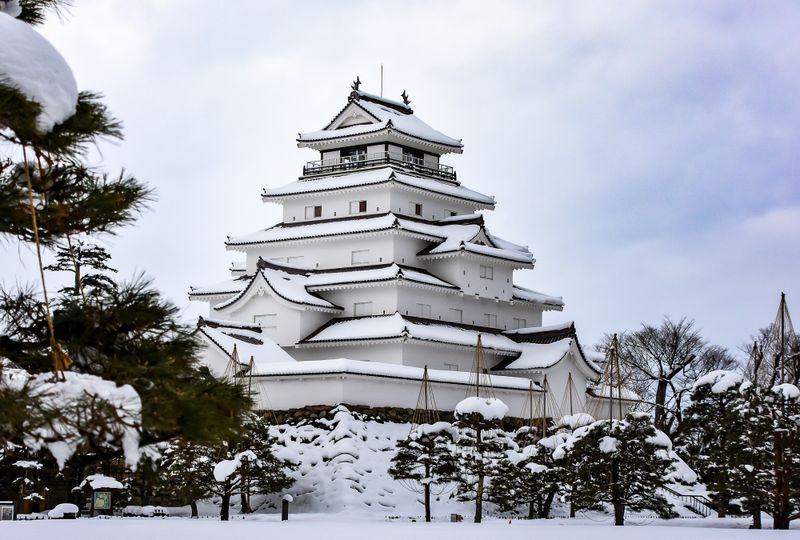
(Tsuruga Castle, a symbol of the city of Aizuwakamatsu, Japan.)
A symbol of the region, Tsuruga Castle towers above a quiet civic district in central Aizuwakamatsu.
The castle demands a visit at any time of year. In summer, however, the open grounds around the main keep bake and the visitor might find themselves chasing between areas of shade. In winter, with a thick carpet of snow covering the grounds and the prospect of more in the air, the brilliant white castle walls almost seem to disappear into the season.
For us, Tsuruga-jo is about as classic in form and appearance as Japanese castles come. The castle, the interior of which was revamped and reopened in April 2023, featured in a recently-published list of seven "must see" castles in Japan by The Mainichi.
Said to be impregnable with no blind angles, Tsuruga Castle and some 5,000 people taking shelter within its walls would eventually succumb to a siege laid by imperial troops during the Boshin War. The castle was surrendered on November 6, 1868 and demolished in 1874. Construction of the castle in its current guise was completed in 1965.
We’ve enjoyed quiet views to the main keep from the high stone wall on the eastern edge of the grounds.
Iimoriyama
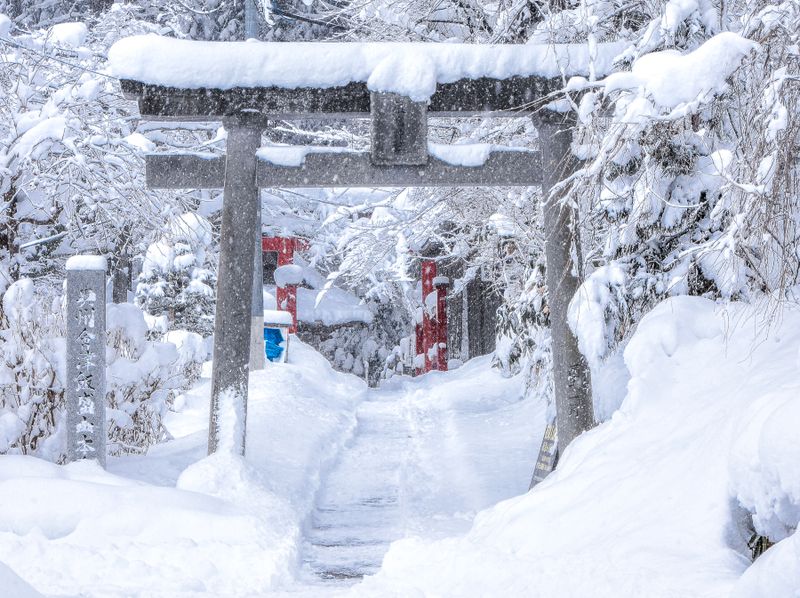
(Shrine torii gate looking even more enchanting decorated in snow, another reason to why you should visit Aizuwakamatsu in winter.)
Iimoriyama is really not much more than a hill east of downtown Aizuwakamatsu. Even so, turning up early one winter morning we were held back by staff who were busy shoveling a path through the heavy snow that had covered the slopes overnight.
Eventually able to approach Iimoriyama's upper reaches, we waded through knee-deep snow to reach the graves of the 19 young Aizu clan samurai, fighting during the Boshin War, who committed seppuku here when they believed their cause to be lost.
The fighters were part of the Byakkotai “White Tiger Unit," the young sons of samurai and not yet out of their teens. A group of 20 Byakkotai are believed to have become separated from their unit during battle, eventually escaping to Iimoriya from where they saw what they thought to be a Tsuruga Castle in flames.
Believing the battle to be over the group attempted ritual suicide. 19 were successful, one was not. They had been mistaken though, it wasn’t Tsuruga Castle which they saw in flames but some of the buildings surrounding the castle.
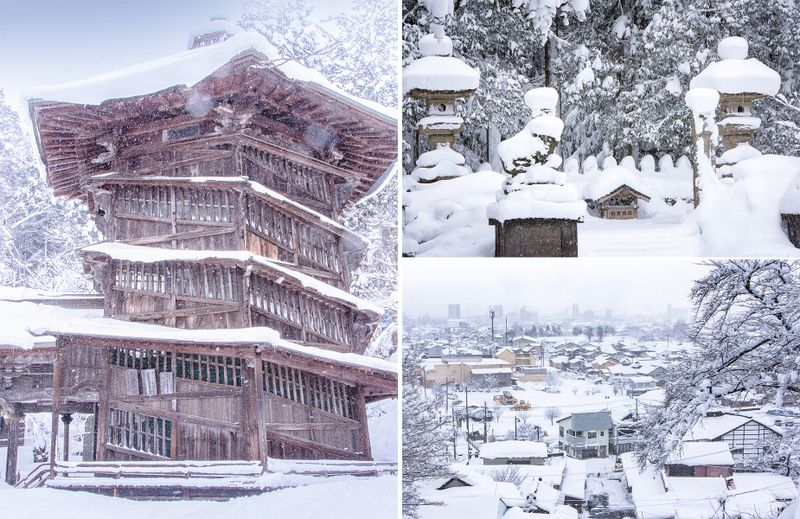
(Buddhist temple Sazae-do (left), the Byakkotai graves (top right) and views over the city of Aizuwakamatsu (bottom right) from Iimoriyama.)
The location of the Byakkotai graves is a sheltered spot at any time, even more so in a thick blanket of snow. Tributes presented by Italy's fascist dictator Benito Mussolini and a representative of Nazi Germany might temper the otherwise poignant mood.
The trail up to the Byakkotai graves veers off to take visitors to the eye-catching Buddhist temple Sazae-do. To us, the odd wooden structure looks like it could collapse with a strong gust of wind. It has been around since 1796 though.
It’s mildly amusing to navigate the temple’s separate ascending and descending spiral staircases which can be navigated without bumping into people coming the other way.
On the lower slopes of Iimoriyama water flows from the exit of the Tonoguchi Dam Cave through which the Byakkotai are said to have escaped after having been cut off from their unit. The torii gates of a small shrine here look magical when decorated with snow.
Oyakuen
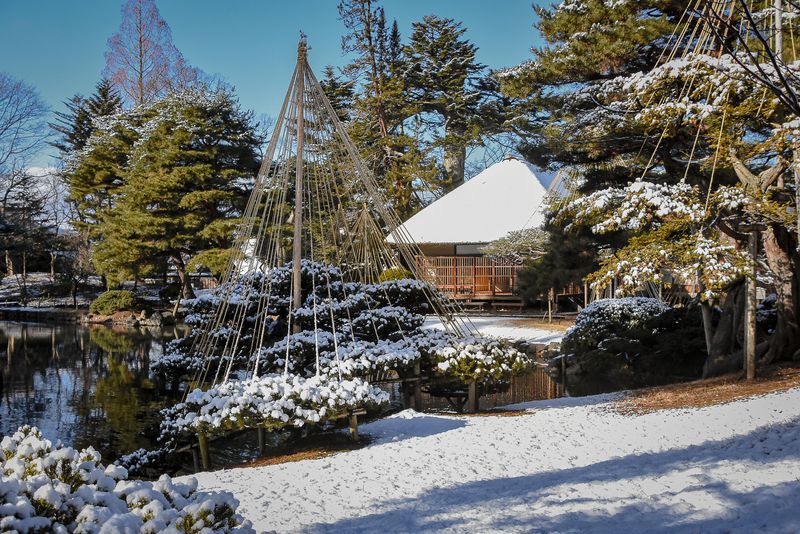
(Winter in Oyakuen garden, Aizuwakamatsu City, Japan.)
One of the Chinese characters used in the name “Oyakuen” means “medicine” and refers to the medicinal herbs grown in this garden by the samurai of the Aizu clan. Original teas made from herbs grown right here can be purchased on site.
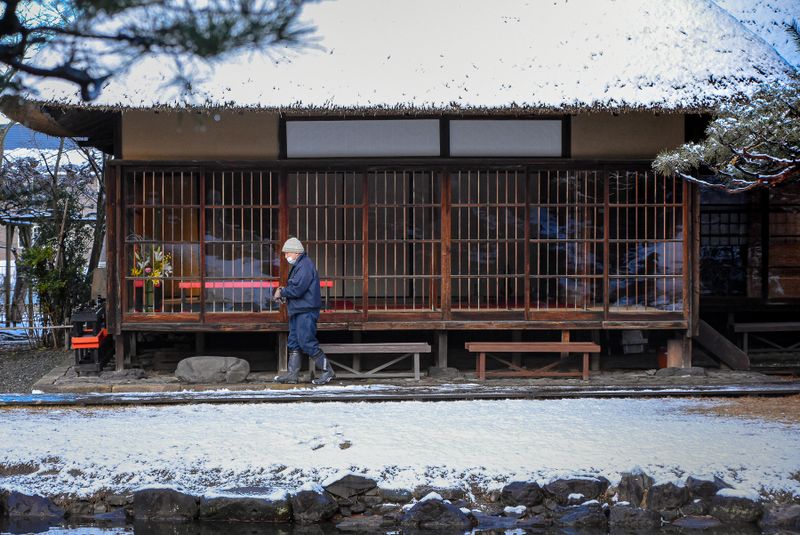
(Staff tending to Oyakuen garden, Aizuwakamatsu City, Japan.)
Herbs aside, the garden has an aesthetic function and features a pond shaped like the Japanese kanji character for “heart.” On a plot of land in the center of the pond sits a tea house which still bears the scars of the Boshin War.
A Japanese garden, in winter, decorated with snow. Enchanting.
Oyakuen is around one kilometer east of Tsuruga Castle and could be visited on the way to Aizu Bukeyashiki.
Aizu Bukeyashiki
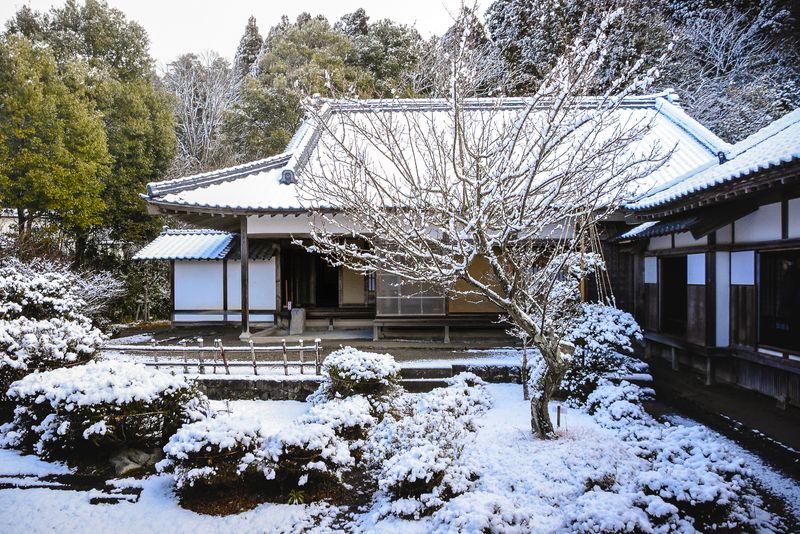
This fine reconstruction of a samurai residence, located on the road headed east out of downtown Aizuwakamatsu, is home to more of the city’s tragic stories.
An antechamber of the family and servants’ area of Bukeyashiki was the site of the ritual suicide by sword - “jijin”- committed by the women and children of the family during the Boshin War. In all, 21 family members committed suicide here during the conflict.
There’s much to explore at the house including, on a lighter note, a lavatory for exclusive use by the feudal lord fitted with features to fend off any potential surprise attack when in an otherwise compromising situation. Let your imagination run free, then come see for yourself.
Aizu Bukeyashiki is a reconstruction of the residence of the samurai Saigo Tanomo (1830 - 1903), chief retainer to the Lord of Aizu.
The original Bukeyashiki was almost completely destroyed during the Boshin War. The reconstruction, completed in 1975, was based in part on drawings found in Tanomo’s residence.
Aizu Hanko Nisshin-kan
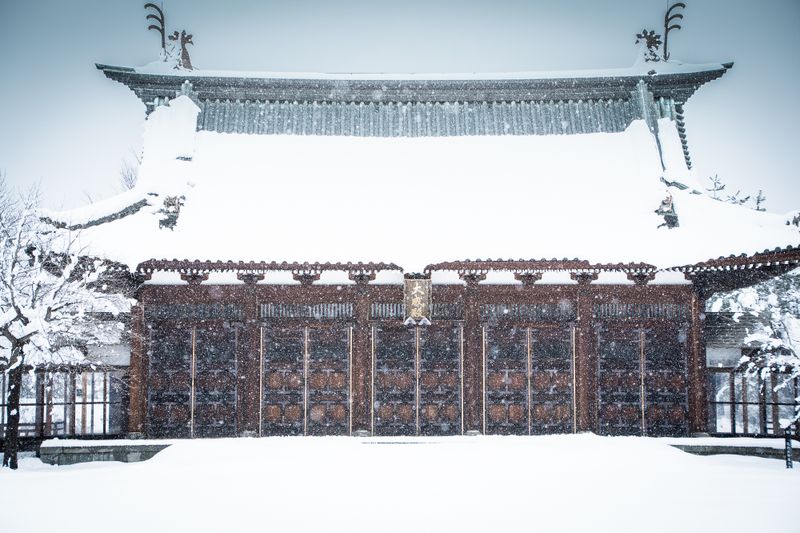
One wonders if the students of samurai clan school Aizu Hanko Nisshin-kan were afforded some form of heating in the classrooms during winter. Even modern-day gas-burning stoves and thick winter socks couldn’t prevent us from shivering our way through the experiences of kyudo archery and zazen meditation available during a visit here.
The school buildings and grounds, including a frozen and very unappealing former “swimming pool,” - or “pond” - of what is said to have been the finest of over 300 Edo-era clan schools in Japan are quiet and carry a stark beauty in winter.
When it was established in 1803 classes at Aizu Hanko Nisshin-kan included those which taught “seppuku,” or ritual suicide by sword.
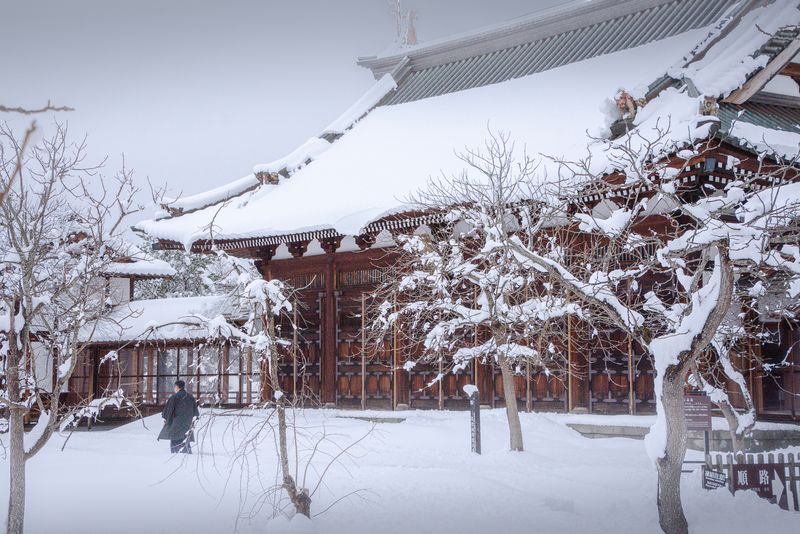
(The grounds of clan school Aizu Hanko Nisshin-kan during winter.)
“They would have understood from their fathers that the samurai have to come to terms with their own death, so it wouldn’t have been so upsetting for them,” a guide told us. Thankfully, no such class is in session at the school today.
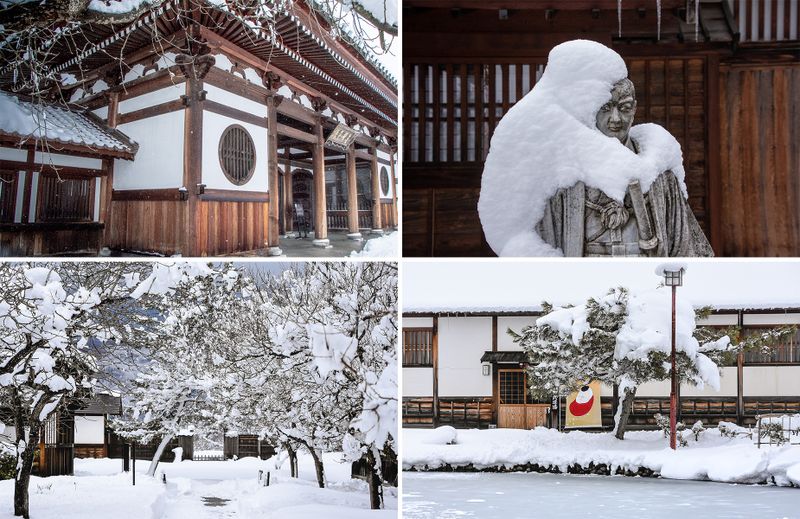
Aizu Hanko Nisshin-kan is a relocated reconstruction of the original school located north of downtown Aizuwakamatsu. The original facility was established near Tsuruga Castle.
Further afield
The hot spring town of Aizu Ashinomaki Onsen can be found in the mountains due south of downtown Aizuwakamatsu in the Ookawa Valley. Challenging access in the past gave the onsen resort the moniker, “phantom village.” At the time of visiting it could be accessed by a 40-minute bus ride from Aizuwakamatsu station.
The hot springs of Aizu Ashinomaki Onsen are believed to have been established over 1,000 years ago.
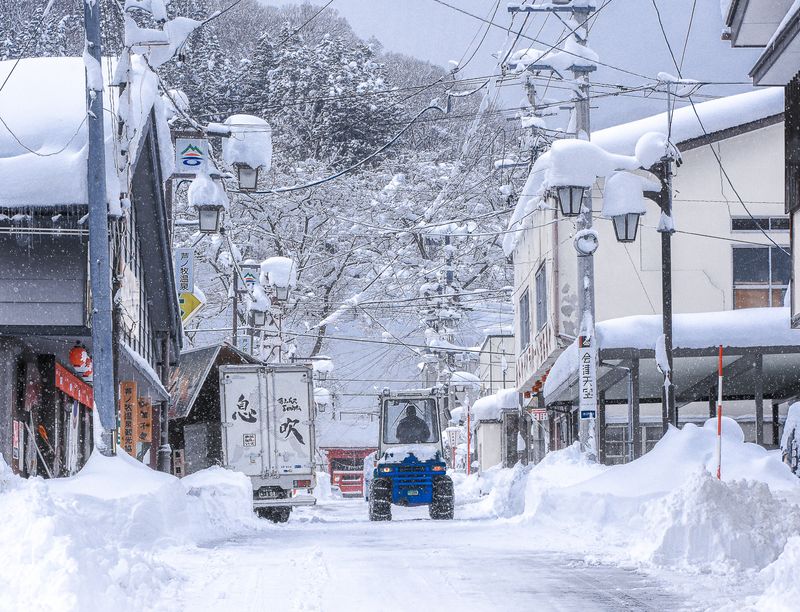
(The streets of hot spring resort Aizu Ashinomaki Onsen in winter.)
Located in the mountains southwest of Aizuwakamatsu City, the remote and beautiful village of Ouchijuku is a well-preserved example of the post towns established in Japan during the Edo Period.
The village is distinct for its many lived-in kayabuki thatched-roofed houses which have remained largely unchanged since their construction during the around 400 years ago. The houses, and the village as a whole, look delightful in the snow. The work of clearing said snow off the roofs, perhaps not so delightful.
Winter conditions can make for a slippery climb up to a viewing point on the mountainside north of the village.
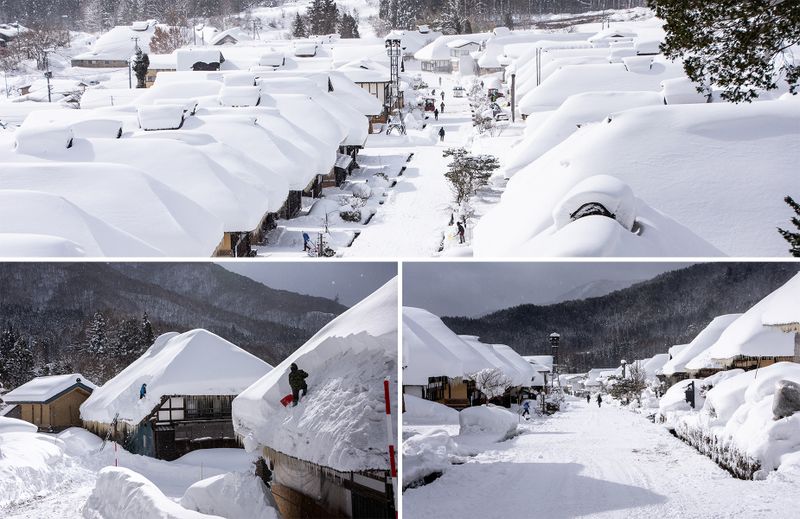
(Kayabuki thatched-roofed houses in the village of Ouchijuku, Fukushima Pref.)
Related
Class still in session at former Aizu samurai school in Fukushima Pref.
[VIDEO] Aizuwakamatsu, Fukushima: Journey to Japan's samurai stronghold



1 Comment
TonetoEdo
on Feb 18
Aizu Wakamatsu is magical in winter! I stayed in the onsen village, strolling from bath to bath in yukata and geta as some of the onsens welcome guests from neighboring hotels. I got a private kashikiri onsen to myself and at one of the roof-top baths watched snow drifting down over the city.